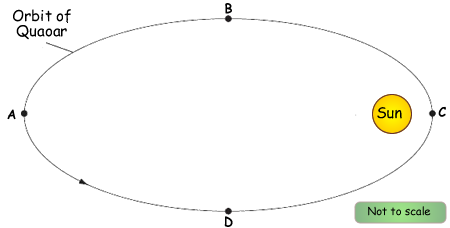Questions on the Earth in Space
Q20.
(a) In 2002 a large asteroid was discovered orbiting the Sun. It was named Quaoar. The diagram below shows Quaoar in four positions in its orbit.

(i) In which of the four positions, A, B, C or D, is the effect of the Sun's gravity on Quaoar the greatest? Explain your answer.
1 mark
(ii) On the diagram above, draw arrows to show the direction of the Sun's gravity on Quaoar in each of the positions A, B, C and D.
1 mark
(iii) At which position, A, B, C or D, is Quaoar travelling most slowly? Explain your answer.
1 mark
(b) The table below gives information about three of the planets in our solar system.
planet |
average distance
from Sun
(millions of km) |
time for one
orbit
(Earth years) |
Average surface
temperature of planet
(ºC) |
Saturn |
1427 |
30 |
–180 |
Uranus |
2870 |
84 |
–210 |
Pluto* |
5900 |
248 |
–230 |
(i) The time for one orbit of the planet Neptune is 165 Earth years. Use the table to estimate the average distance of Neptune from the Sun.
1 mark
(ii) How does the surface temperature of these planets vary with distance from the Sun? Use information in the table to help you.
1 mark
(iii) Explain why the temperature varies with distance from the Sun in this way.
2 marks
(maximum 7 marks)



